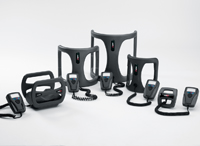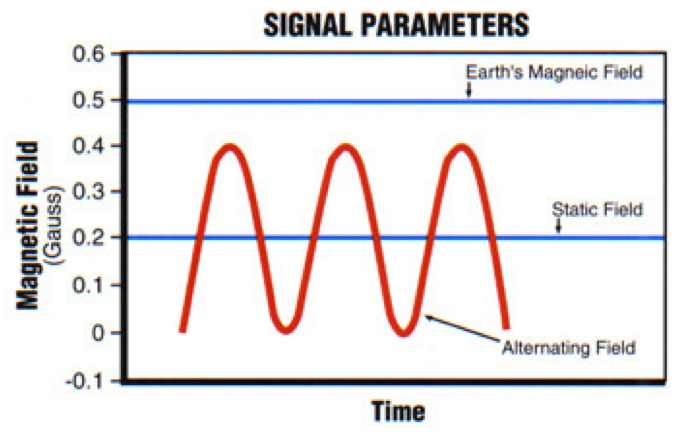more at EdsStuff
Their acronym CMF stands for "combined magnetic fields," that is, static + alternating, and they have a CMF patent, a CMF trademark and a CMF corporate division.

 "Basic Wave Properties
"Basic Wave Properties
All Electromagnetic Fields (EMFs) travel in waves. If one looks at a standard electromagnetic wave, the top of each wave is called the crest and the base is the trough. Two important characteristics that can be measured from these points are wavelength and amplitude. Wavelength is measured from the crest of one wave to the crest of the next . Amplitude is measured from the trough of one wave to the crest of the next.
Wavelength tells us the frequency of the wave, or how fast it is repeating. Each time the wave repeats it is considered a pulse of energy. Frequency is typically measured in Hertz (Hz), which is another way to count how many pulses per second are occurring. Wavelength and frequency are inversely proportional, meaning when the wavelength gets smaller, more waves occur in the same time frame. Amplitude tells us the strength, or power of a wave. These characteristics are what make the CMF technology unique.
CMF Bone Growth Stimulators Combined Magnetic Field (CMF) Signal
The signal is what differentiates the CMF OL1000 and SpinaLogic from other products. Prior to the CMF OL1000, technologies dated back to the mid-1970s, and the science behind these technologies remains unexplained. The founder of the CMF OL1000 began research in the 1980s to understand the dynamics of EMF technology and to identify specifically which signal characteristics stimulate bone cells and in turn promote healing. The CMF OL1000 signal is actually a combination of two 'waves,' an alternating EMF superimposed in parallel over a static EMF. Having these two fields is the main feature that differentiates our products. The frequency of the alternating EMF is exactly 76.6Hz and the amplitude is 0.2-0.4 gauss (a measure of electromagnetic energy).
In the early 1990s, a group of researchers conducted a study on the optimal range of frequencies to stimulate bone cells. The researchers found that EMF frequencies in a range from 0-150Hz had the most effect on stimulating bone cells.McLeod1992 Since the frequency of the CMF signal is 76.6Hz, 100% of the signal is within the optimal range of 0-150Hz. The reason CMF technology is potent (and only requires 30 minutes per day) is because 100% of the signal falls within the optimal range of frequencies. Researchers also found that CMF treatment continued beyond 30 minutes had no statistically significant incremental healing affect. The 30-minute treatment equates with good patient compliance, which can be linked to overall efficacy. Overall patient compliance will lead to a better overall results and a better tool for the physician to use in practice." -- End of DonJoy quote --
The convention for sine wave amplitude is half of what is stated. Waves do not pulse energy per wavelength. Amplitude and wave power are not the same. Frequency, wavelength and amplitude are definitions with no inherent physics - and do not attest worth of CMF. Static fields do not induce anyting, so there is no such thing as "static EMF."
The discussion says that induced voltage is what stimulates bone growth. That is undoubtedly correct, but it means that "CMF" is irrelevant medically. The static part of the magnetic field does not induce any voltage. On the other hand, "CMF" is wasteful because maintaining the static field component draws power from the batteries. With oscillating field only, and no static field, the DonJoy growth simulators would run 1+√2 = 2.4 times as long on a set of batteries.
McLeod and Rubin wrote, "The osteogenic influence of the sinusoidal electrical fields was strongly dependent on the frequency; the 150, 75, and 15 Hz sinusoidal fields, respectively, generated a -3 per cent, + 5 per cent, and + 20 per cent mean change in the bone area." So McLeod and Rubin say that the DonJoy frequency of 76.6 Hz is more than four times worse for stimulating bone healing than 15 Hz would be. Why does DonJoy cite the McLeod and Rubin paper?
The induced voltage amplitude V is frequency f times the original amplitude of the magnetic field B, V = f B. The McLeod and Rubin abstract gives no comment about whether they did or did not maintain the same induced voltage at all of their frequencies. Did they increase amplitude for the lower frequencies?
Vector summation of the DonJoy and the earth's magnetic fields depends on orientation:


But that is irrelevant. The induction referred to by McLeod, et al. is independent of all static magnetic fields, the induced voltage being proportional to the rate of change of the sinusoidally varying magnetic field. As mentioned, the amplitudes are related by V = f B, where B is amplitude of oscillation without any static component. The time picture is that the rate of change of a sine wave is a cosine:

In addition to being proportional to field rate of change, f B, the induced voltage has a spatial dependence as well. This depends on the geometry and spatial non-uniformity of the time oscillating magnetic field. In a sample with high electrical resistance when placed in a magnetic field that is approximately spatially uniform within a cylinder (as at the center of a Helmholtz coil pair) voltage is proportional to f B times the radius from the center line of the coils. Induced voltage goes to zero near the center of the coil and this low induction region is physically large if the sample has high electrical conductivity.

One of the DonJoy device configurations looks close to a Helmholtz coil set, and so might impart low induction and low healing in the vicinity of its geometric center. The others look like their coils are oriented at about ninety degrees to each other, which might be ideal.
Magnetic wave amplitude in Gauss is not a measure of electromagnetic energy. The power propagated by an electromagnetic wave is proportional to frequency f times the square of the amplitude B, f B2. Induced voltage power should be proportional to f (fB)2 = f3 B2. As frequency goes down less power goes into Ohmic loss in the sample and more is radiated into space.
The McLeod, et al. abstract gives no insight as to why bone healing improves when frequency of the applied field is lowered. My guess is that the most beneficial effect for bone growth might be when the voltage applied across the gap in the broken bone is fixed and static, or at least very low in frequency similar to normal body motions. Zero or near-zero frequency voltages can be achieved only with electrodes implanted surgically, and this is apparently done if all else fails.
Induced voltages have to be alternating. And the magnitude of induced voltage drops off in proportion to frequency (for a given coil current and magnetic field strength). So the 15 Hz might just be a good enough, achievable compromise.